AUTHOR GUIDELINES
For all submissions, please follow the general format below:
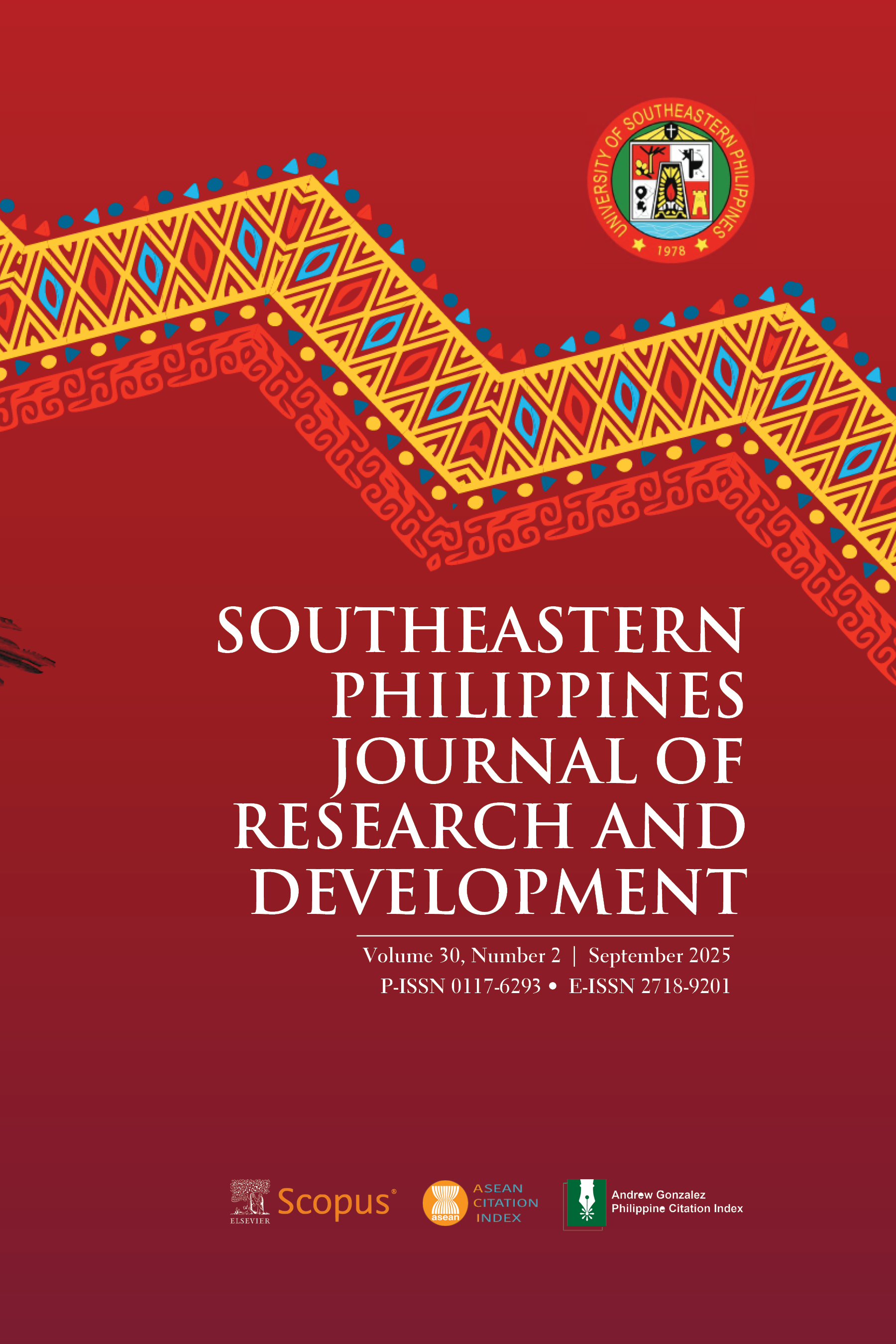
Editorial Preface
Our journal’s increasing influence has been reaffirmed once again, as we have achieved a Q2 (second quartile) ranking, placing us in the top 25% of the most influential multidisciplinary journals worldwide, based on the latest Scopus data used for the 2024 Scimago Journal and Country Rank (SJR) rankings as of March 2025. Within the same subject category, SPJRD claims the top spot in the Philippines while ranking third across all subject areas. It further attests to the scientific rigor of our publishing articles since 2021. In the SPJRD Vol. 30, No. 2, we continue this commitment by featuring critical engagements about the Mindanao and ASEAN regions, conducted by researchers from Indonesia, Oman, Iraq, Portugal, Malaysia, the United Arab Emirates, Japan, Pakistan, Thailand, the United States of America, and the Philippines.
The September 2025 issue opens with three education-related articles that employ mixed-methods approaches. In Adapting Early Childhood Curriculum to Technology: Insights from South Sulawesi, Indonesia, Herlina, from Universitas Negeri Makassar in Indonesia, provides actionable insights for creating adaptable, technology-responsive curricula and advocates for ongoing investment in professional development and infrastructure in developing contexts. In AI-Powered Personalization for Learning and Human-Robot Interaction: A Case Study with Pre-Service Teachers from Indonesia, Ahmad Al Yakin and Mutmainnnah Mutmainnah of Universitas Al Asyariah Mandar in Indonesia, Luis Cardoso of the University of Lisbon in Portugal, Ali Said Al Matari of the A’Sharqiyah University in Oman, and Ahmed J. Obaid of the University of Kufa in Iraq highlight the effectiveness of AI tools in fostering meaningful collaboration, offering insights for future policy and curriculum development in technologically emergent regions. In Child-Friendly ALS Learning Spaces: A Regional Study in Northern Mindanao, Philippines, Ray Butch D. Mahinay of the City College of Cagayan de Oro, Philippines, Edralin C. Manla of the Xavier University of the Ateneo de Cagayan in Cagayan de Oro City, Philippines, Nancy S. Ramores of the Philippine Normal University in Manila , and Amparo V. Dinagsao of the Heritage University in Toppenish, Washington, United States of America examine how ALS Community Learning Centers (CLCs) in the region align with UNICEF’s Child-Friendly School (CFS) framework. Their pioneering study represents the first integration of the CFS framework into ALS research in the Philippines, contributing regional evidence on sustainable, rights-based education systems and offering a contextual model for adapting child-friendly principles to second-chance learning in Southeast Asia.
Moving on to social issues, the next research articles bring us to the struggles and hopes of the people of Mindanao and Sulu. In Buried Memories, Imagined Wealth: Yamashita Treasure as Collective Memory in Everyday Life in Mindanao by Fumiko Murota of Kyoto University in Japan, the author scrutinizes the contemporary meanings embedded in the continued narratives of the Yamashita Treasure, particularly through the lens of “remembering and forgetting” war memories. Murota believes that while the treasure’s existence remains uncertain, its imagined presence generates a sense of possibility—a hope for future prosperity grounded in a painful past. In Hula-Bangsa-Agama as Padduman: Reclaiming the Tausug Doctrine of Statehood and Islamic Political Identity, Hannbal H. Bara and Nagder J. Abdurahman of the Mindanao State University in Sulu articulate how Islamic governance can be understood through localized epistemologies, thereby contributing to broader discourse on decolonization, Islamic political thought, and Southeast Asian indigenous sovereignty.
Enlarging our consciousness on language and culture are the next four research articles in this edition. In Expressions of Reassurance in the Quran: A Speech Act Analysis, Hekmat Abed Daifallah Khazaleh of the National Charity Schools, United Arab Emirates, and his co-authors from Universiti Malaya study the Quran’s sophisticated use of speech acts to provide divine and prophetic support, offering insights into the pragmatic dimensions of religious discourse. In The Language of Praise and Worship: A Corpus Analysis of Register Variation in Christian Songs , Raymund T. Palayon of the King Mongkut’s Institute of Technology in Thailand, and Irish F. Dalona of the Mindanao State University- Iligan Institute of Technology investigate the key linguistic features in the two sets of Christian songs—church hymns and contemporary Christian songs—to illustrate their register variation, using multidimensional analysis, key semantic tag analysis, and key part-of-speech analysis. Their study provides a framework for characterizing the linguistic features of worship songs from non-Christian contexts, enabling future research to compare religious music across different traditions. In Language Encounters in Public Parks: Mapping the Linguistic Landscape of Davao City, Philippines, Prizza Mia Pil and her counterparts from the University of Southeastern Philippines (USeP), Mindanao State University in General Santos City, Philippines, and Government Arts and Commerce College Larkano in Larkana, Pakistan point out how signs serve both regulatory and identity functions in public spaces, thus recommending the inclusivity of signage policies that enhance cultural representation, particularly of indigenous languages. Their paper contributes to the understanding of the role of multilingualism in public spaces, identity, and accessibility. In An Archival Study on the Linguistic State of Obo Manobo and Kinamiging Manobo, Mae-Ann Gasing of USeP and Mohammad Ali Al-Saggaf of Xiamen University Malaysia in Selangor, Malaysia, find out that Obo Manobo is relatively well-documented while Kinamiging Manobo is under-researched. They highly recommend that future researchers investigate the current use and vitality of two threatened Manobo languages spoken in Mindanao, the documentation of oral literature, and the regional variations of Obo Manobo and Kinamiging Manobo to document and map dialectal differences, if any.
The last research article in this issue, Antimicrobial Activity of Uvaria rufa (Annonaceae) Leaf Extracts, deals with the potential antimicrobial activity of Susong kalabaw (Uvaria rufa), which usually grows abundantly in the tropics of Africa and Asia, particularly in Indonesia, Thailand, Malaysia, and in low and medium-altitude forests in the Philippines. Lawrence R. Delgado, Rane Angelica G. Alarcon, Kyla Shane C. Aldea, Trisha Anne B. Samaniego of the Adamson University in Manila, Philippines, and their co-investigators from the University of Texas School of Public Health in USA and University of the Philippines Manila conclude that crude and fractionated leaf extracts of U. rufa demonstrated promising antibacterial activity against bacterial samples in the Kirby-Bauer test and Minimum Inhibitory Concentration (MIC) assay. Their findings highlight the potential of susong kalabaw as a locally available plant that may one day be developed into affordable natural remedies for common infections, especially valuable in communities facing limited access to conventional medicine.
This issue closes with three reviews of books on indigenous cultural communities in Mindanao and Sulu. Aurelio S. Agcaoili of the University of Hawaii at Manoa, USA, explicates the plausibility and intellectual strength of the book Indigenous Knowledge Systems and Practices on Disaster Risk Reduction and Management of Selected IP Groups in the Davao Region, published by USeP, and suggests broader integration of indigenous voices in policymaking and future research directions (e.g., generational participation, gendered impacts of disasters). Nikodemus Niko of Chulalongkorn University in Thailand acknowledges the book “Kapandayan: A Journey to the Wisdom of Selected IP Groups in the Davao Region” as both a cultural archive and a tool for advocacy. In discussing this USeP-published book, Niko offers potential pathways such as conducting comparative studies among indigenous groups in Mindanao, the Sulu Archipelago, and Palawan, and integrating indigenous epistemologies into the national curriculum to enhance academic contribution. Ricardo de Ungria of the University of the Philippines Mindanao critically assesses the three anthologies under Gutierrez Mangansakan II by connecting to the political and cultural realities of the Bangsamoro. He stresses that these three anthologies are laying the foundations for an invigorated modern Moro literature in the next few years—one that is not only forward-looking but also rooted in the older traditions whose blood and barakah continue to flow into the new generations of creatives.
Critiqued by our international advisers and reviewers, we hope that this edition’s conversations, based on a rigorous examination of various issues, will spur research and extension projects, as well as policy formulation, for the development of Mindanao and the ASEAN regions.
SAJED S. INGILAN
SPJRD Editor-in-Chief
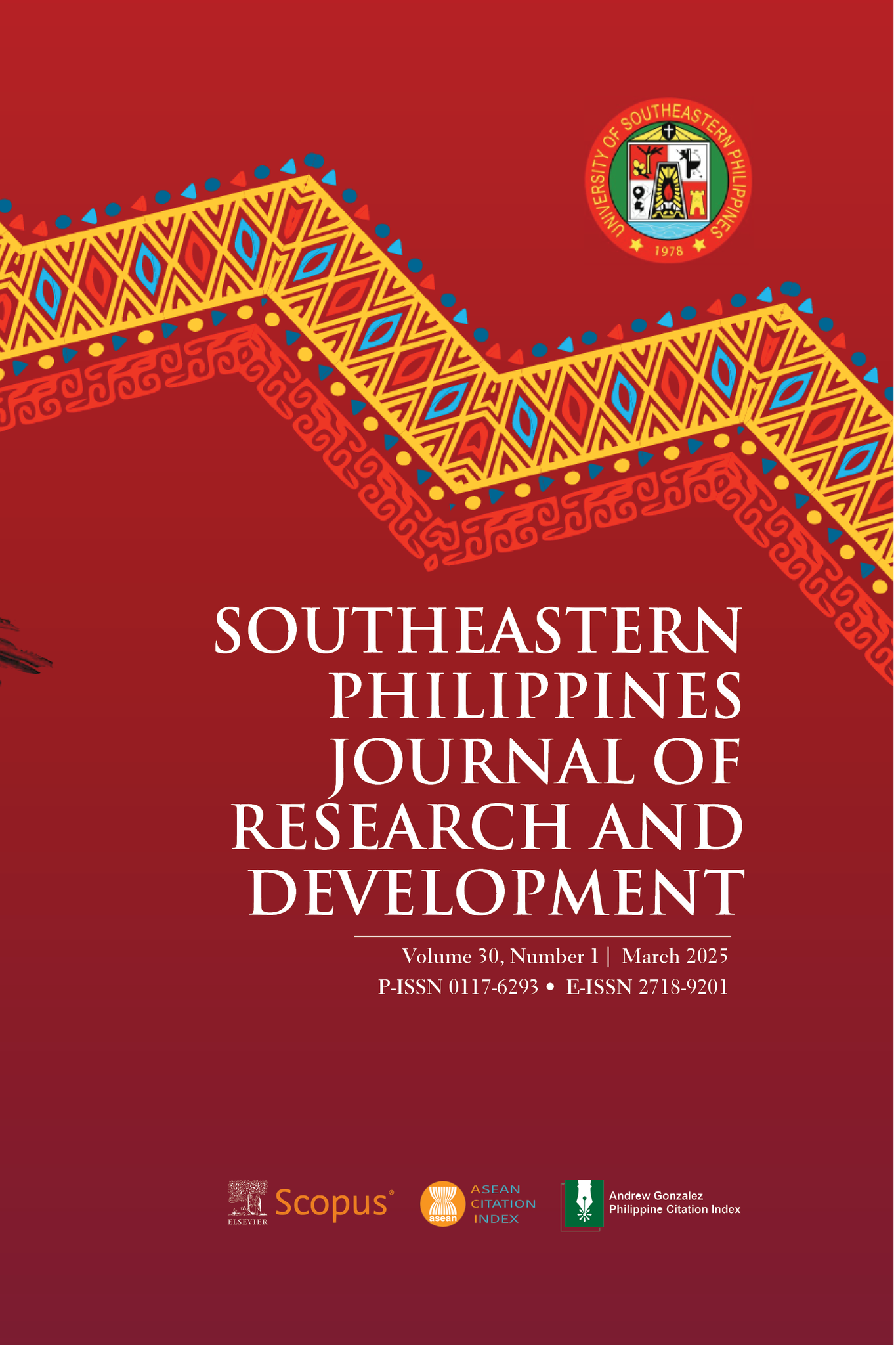
Editorial Preface
Over the years, the Southeastern Philippines Journal of Research and Development has been committed to promoting scholarship about the development needs of Mindanao and ASEAN regions. The March 2025 issue continues this tradition as it features contributions from Malaysia, Thailand, Indonesia, and the Philippines. Out of 267 submissions, nine papers passed the triple-blind review, ensuring that they are aligned with the standards of scholarly publications and are responsive to the Sustainable Development Goals.
The first five articles in this issue deal with sociocultural studies about Muslims, enlarging our consciousness of who and how they are as a people. In Folklore, Identity, and Tourism among Thai Muslims in Koh Yao, Andaman Sea, Thailand, Rungrat Thongsakul of the Phuket Rajabhat University in Thailand and Hanafi Hussin of the Universiti Malaya in Malaysia investigate the preservation of Muslim folklore and identity and how it could be developed as a cultural tourism product. On the strength of rigorous fieldwork, Thongskul and Hussin proffer that the folklore practices of Thai Muslims in Koh Yao could be enhanced and promoted as activities by fostering collaboration across sectors while safeguarding their rich cultural heritage.
If the study of Thongskul and Hussin focuses on the Muslims in Koh Yao, Andaman Sea, Thailand, the work of Christopher Ryan B. Maboloc, Mussolini S. Lidasan, and Mansoor L. Limba of the Ateneo de Davao University, and Rasul M. Salik of Notre Dame University in Cotabato City, Philippines, looks at the condition of the Muslims in Mindanao, Philippines from the vantage point of Pogge (2008) and Young (2000). In Unveiling Structural Poverty in Muslim Mindanao: Focus on Power Dynamics and Economic Injustice, Maboloc and his co-authors argue for structural reforms beyond state-centric measures to sustain peace and development in Muslim Mindanao. They firmly believe that changing the power dynamics in the Bangsamoro region is necessary if people are to benefit from authentic autonomy.
Still on the Muslims in Mindanao, Mohammad Ammar G. Mangondato and Sharisse May M. Barra of the Mindanao State University Marawi City, Philippines in The Unspoken Turmoil of the Siege: Unraveling the Lived Experiences of the Bereaved Mothers of Child Soldiers in Lanao del Sur, Philippines, narrates that the bereaved Meranaw Muslim mothers have been experiencing immense psychological challenges since the Marawi siege erupted up to this time, but they affirmed that they need to practice sab’r (patience) for what happened to their sons is because of qad’r (divine decree). The researchers recommend including the entire family dynamics to understand how the family experiences the Marawi siege and how they interact to help each other.
An equally significant contribution to the Muslim Mindanao discourse is the work of Mark Aljen D. Binocal of the Davao Oriental State University and Ele D. Lunzaga of the Adventist University of the Philippines. In Understanding the Social Cognitive Motivations for Jihad Among Muslim Millennials in Southern Philippines: A Psychological Perspective, Binocal and Lunzaga elucidate that the Muslim millennials have a positive outlook on jihad, a nuanced perspective that allows us to get a better sense of the ideology sans the biases against its interpretation. Their paper highlights the call for a well-rounded and informed perspective on jihad – fisabilillah (struggle in the way of God) and jihad al nafs (struggle against the self), especially within education, religious, and community environments.
As important as recognizing the teaching of the Qur’an is the study of the Hadith (traditions) of Prophet Muhammad (Peace be upon him). In Figures of Speech in the Hadith of Prophet Muhammad: An Analysis of Tashbīh, Isti‘ārah, and Kināyah, Mohammad Hussin, Mohammed H. Al Aqad, Syakirah Rifa’in @ Mohd Rifain of the Universiti Malaya and Yoyo of the Universitas Ahmad Dahlan in Yogyakarta, Indonesia emphasize the need for scholars, translators, and interpreters of Hadith to master bayān elements for a more precise and contextually faithful understanding of the Prophet’s speech. This has direct implications for Arabic rhetoric, Islamic studies, and translation studies, particularly in preserving the rhetorical and semantic depth of Hadith.
This edition proceeds with an additional work on linguistics. Further emphasizing the necessity of accounting for the indigenous languages in the Philippines is the archival research, The State of Blaan and Tboli Linguistics. Rudelyn V. Bantilan of the Ramon Magsaysay Memorial Colleges in General Santos City, Philippines, and her co-writers from the University of Southeastern Philippines and Universitas Negeri Makassar in Indonesia conclude that the majority of the studies in Blaan and Tboli linguistics were done by non-Filipino scholars, underscoring the need for local researchers’ involvement in documenting, developing, and sustaining these languages.
The following two studies provide a picture of the society and agriculture in Indonesia. In Surviving the Edges: Multidimensional Poverty among Indigenous Women Community in Remote Rural Areas in Indonesia, Nikodemus Niko of the Maritime Raja Ali Haji University in Tanjungpinang, Indonesia, articulates that based on his ethnographic research, poverty among Dayak Benawan women is not merely an economic issue but is deeply ingrained in a complex interplay of social, cultural, and environmental factors. He then advocates for targeted policies aimed at promoting social equity for indigenous communities in Indonesia.
Shifting to agriculture in Indonesia, Akhmad Zamroni and Wahyu Endah Christiani Putri of the Institut Teknologi Nasional Yogyakarta in Indonesia and their co-researchers from the Philippines in their publication, Nature-based Solutions for Agricultural Drought Adaptation Strategies in the Karst Area of Gunungkidul Regency, Indonesia, propose NBS address drought challenges, zeroing in on increasing water retention capacity as the most effective strategy. Recognizing the limitations related to data availability and uncertainties regarding the long-term effectiveness of the proposed strategies across different climate scenarios, the researchers highly suggest doing longitudinal studies and comprehensive monitoring systems to evaluate their long-term effects on agricultural productivity and ecosystem resilience.
Staying on the scholarship in agriculture, but this time from Southern Philippines is the contribution of Melissa P. Loquias, Shemaiah Gail P. Placencia, and Larry A. Digal from the University of the Philippines Mindanao titled Choice of Agri-credit Source among Cavendish Banana Farmers: Evidence from Southern Philippines. Using a multinomial regression model, their findings can potentially aid the government in crafting policies and interventions relating to improved access to formal credit, especially in the context of the export industry.
Meticulously reviewed by scholars from America, Asia, Australia, and Europe, the articles in this edition are critical examinations of the conditions and issues concerning Mindanao and ASEAN regions, urging the readers to interrogate and resonate through formulating policies and collaboratively doing research and extension programs for a sustainable humanity.
SAJED S. INGILAN
SPJRD Editor-in-Chief
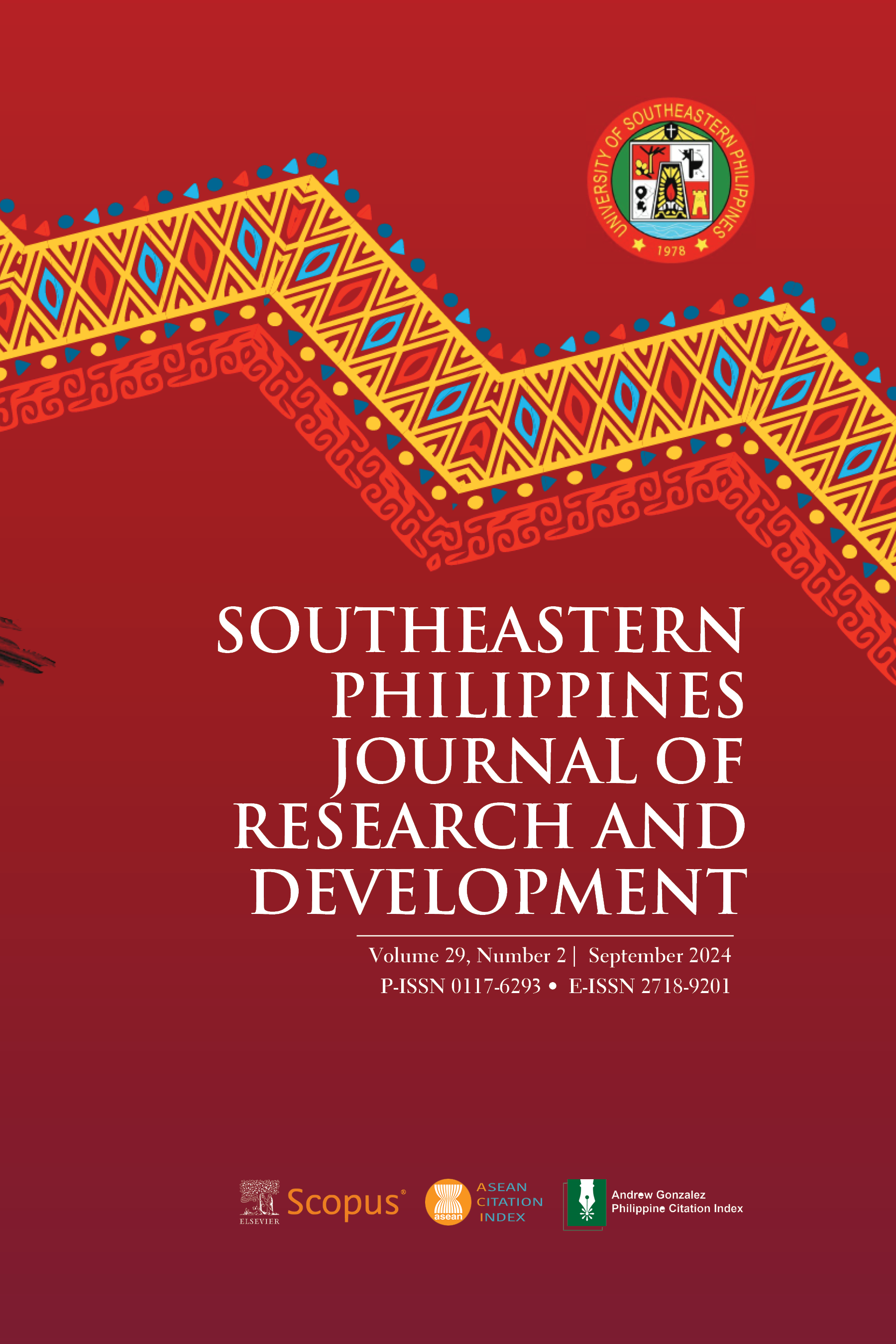
Editorial Preface
The studies in this issue stimulate discussions on the ASEAN region development needs. Readers are invited to revisit and re-think their assumptions by examining the works of our contributors from Japan, Vietnam, Indonesia, India, Malaysia, United States of America, Oman, and the Philippines. Responsive to the Sustainable Development Goals, only 12 articles out of 216 submissions made it to this edition. The SPJRD, from earning a spot in Scopus database in September 2023 to earning an entry in ASEAN Citation Index database in July 2024, commits to publishing high-quality articles through rigid evaluation by our competent international advisers and reviewers.
The first four articles in this edition deal with agriculture. In Milk Culture in Insular Southeast Asia Recognized as a Non-milk Cultural Sphere, Masahiro Hirata of the University of Agriculture and Veterinary Medicine and Takashi Tsuji of the International Research Centre for Intangible Cultural Heritage in the Asia-Pacific Region, both in Japan, examine the issues of milk processing techniques and milk use in places such as the Philippines and Indonesia. Their paper significantly contributes to analyzing how the transmission and transition of milk culture in areas considered outside the milk cultural sphere.
In the second article, Valuation of Food Security and Cultural Landscape Services for Paddy Ecosystems in Developing Countries: A Case Study in Honghai, Vietnam, Ngoc Trinh Phuong of the Tan Trao University in Vietnam proposes some policy implications for Vietnam and similar low-living provinces, helping them to promote poverty reduction methods and develop sustainable tourism based on paddy ecosystem services.
From the paddy ecosystems in Vietnam, this issue continues by featuring the paper, Insights from Insect Diversity and Functional Roles in Sorghum Pest Management: A Case Study from Northern Sumatera, Indonesia. Amelia Zuliyanti Siregar, Tulus, and Yunilas of the University of Sumatera Utara, and Ravindra Joshi of the Malla Reddy University in India stress the importance of biodiversity conservation and effective management practices for sustainable sorghum cultivation in Northern Sumatera, Indonesia.
Staying on the scholarship in agriculture is a contribution from the Philippines titled, Effects of Vermicast and Arbuscular Mycorrhizal Fungi (AMF) on the Establishment of Cacao (Theobroma cacao Linn.) Seedlings Grown in a Degraded Soil. The findings of the study of Dernie Olguera of the University of Southeastern Philippines (USeP) and Jake Baga-an of the Santo Tomas College of Agriculture, Science, and Technology in Davao del Norte could help the farmers increase the productivity of cacao in a degraded soil environment.
The next two articles focus on the people and society in mainland Mindanao, Philippines. In Challenges, Capabilities, and Proposed Initiatives for Capacity-Building Among Shelter Beneficiaries in Davao City, Philippines: A Case Study, Francis N. Reginio of USeP and Aurelio S. Agcaoili of the University of Hawaii at Manoa develop a model that emphasizes sustainable networks and community development initiatives to improve living conditions, prevent dependency, and ensure active involvement among the shelter beneficiaries in Davao City.
If the publication of Reginio and Agcaoili looks at the welfare of shelter beneficiaries, the article of Reymark P. Malinda of the University of Science and Technology of Southern Philippines and Benjamin Paula G. Flor of the University of the Philippines Los Baños considers the health of the farmworkers. In A Narrative Inquiry into the Meaning of Smoking among Farmworkers in Southern Philippines, Malinda and Flor recommend to strengthen the anti-smoking campaign in the Philippines and revisit the enforcement of the relevant laws and ordinances in order to forestall the ballooning scourge of smoking.
This issue progresses by presenting works on the Tausug and Sama culture. In Maligay: An Iconic Tausug Traditional Token for Pagtammat in the Sulu Archipelago, Eddie M. Ladja and Cherry Mae L. Ladja of the Western Mindanao State University (WMSU) in Zamboanga City, Philippines highlight the cultural and educational practices of Tausug families in rural Sulu, zeroing in on its continued relevance and resilience in the face of modernization.
Working on the same Tausug principle, the hula-bangsa-agama (homeland-identity-religion) is the paper titled Tabiat Kariasali: The Affiliative Leadership of the Informal Taumaas of the Suluk Community on the East Coast of Sabah, where Nurhasan Danial and Asmiaty Amat of the Universiti Malaysia Sabah and their colleagues from the Mindanao State University- Tawi-tawi College of Technology and Oceanography (MSU TCTO), and MSU Sulu proffer unique insights into the tabiat kariasali (instinctual role) and functions of the taumaas (leaders) which are valuable in understanding the indigenous leadership and kahanungan (peace) in the Suluk community.
Still on the people of Sulu Archipelago, Alshadat Sabal of MSU TCTO in Sulat Pasa: Its Implications to Local Divorce Practice among the Sama of Tawi-tawi, Philippines, articulates that the Sama continue to present and bring their divorce cases to the lumah sarah (traditional authority) for enforcement. As a time-honored tradition among the Sama, Sabal ends his paper by proposing a measure to institutionalize the sulat pasa (traditional divorce paper) as also legal, and binding taking into account issues of accessibility, affordability, practicability, and feasibility.
Showcasing another aspect of Sama culture is the paper, Ethno-Science, Technology, Engineering, and Mathematics (EthnoSTEM) Ideas in the Sama Mat-Weaving. Based on ethnographic research in Tandubas, Tawi-tawi, Aljemedin Jaudinez of MSU TCTO and Ma. Nympha Joaquin of UP Diliman conclude that the ideas in Sama tepo (mat) weaving are loaded with scientific affluence that should be preserved to preclude them fading to oblivion. They underscore the need for the Philippine Department of Education to include the EthnoSTEM ideas in Sama tepo in preparing culturally sensitive materials, thus advancing an inclusive education for all.
An additional publication on the indigenous cultural communities in Mindanao, Philippines is titled The Development of Kalagan and Isamal Linguistics: An Archival Research. Through synthesizing various legitimate sources, Jessa Jane Iglesia and her counterparts from USeP and the University of Nizwa in Oman report that while significant research has been conducted on Kalagan linguistics, the trend is the opposite for Isamal linguistics. The researchers prompt scholars, particularly those from the Philippines, to conduct research on the country’s indigenous languages.
Readers will find equally fascinating this edition’s last article, A Social Network Analysis in Abu Sayyaf Kidnappings. Laica Pearl Alcantara, Brenz Gwynne Hababag, Blessy Tale, and Jamal Kay Rogers of USeP comprehensively analyze Abu Sayyaf Group’s kidnapping incidents to better understand their operational structures, patterns, and dynamics. The findings offer extremely valuable information about how the ASG has developed and changed over the years, serving as input to concerned agencies in dealing with national security.
It is with optimism that the articles in the edition will allow for more meaningful conversations on the ASEAN region development needs, leading to impactful Research, Development, and Extension (RDE) projects for the benefit of the present and future generations.
SAJED S. INGILAN
SPJRD Editor-in-Chief
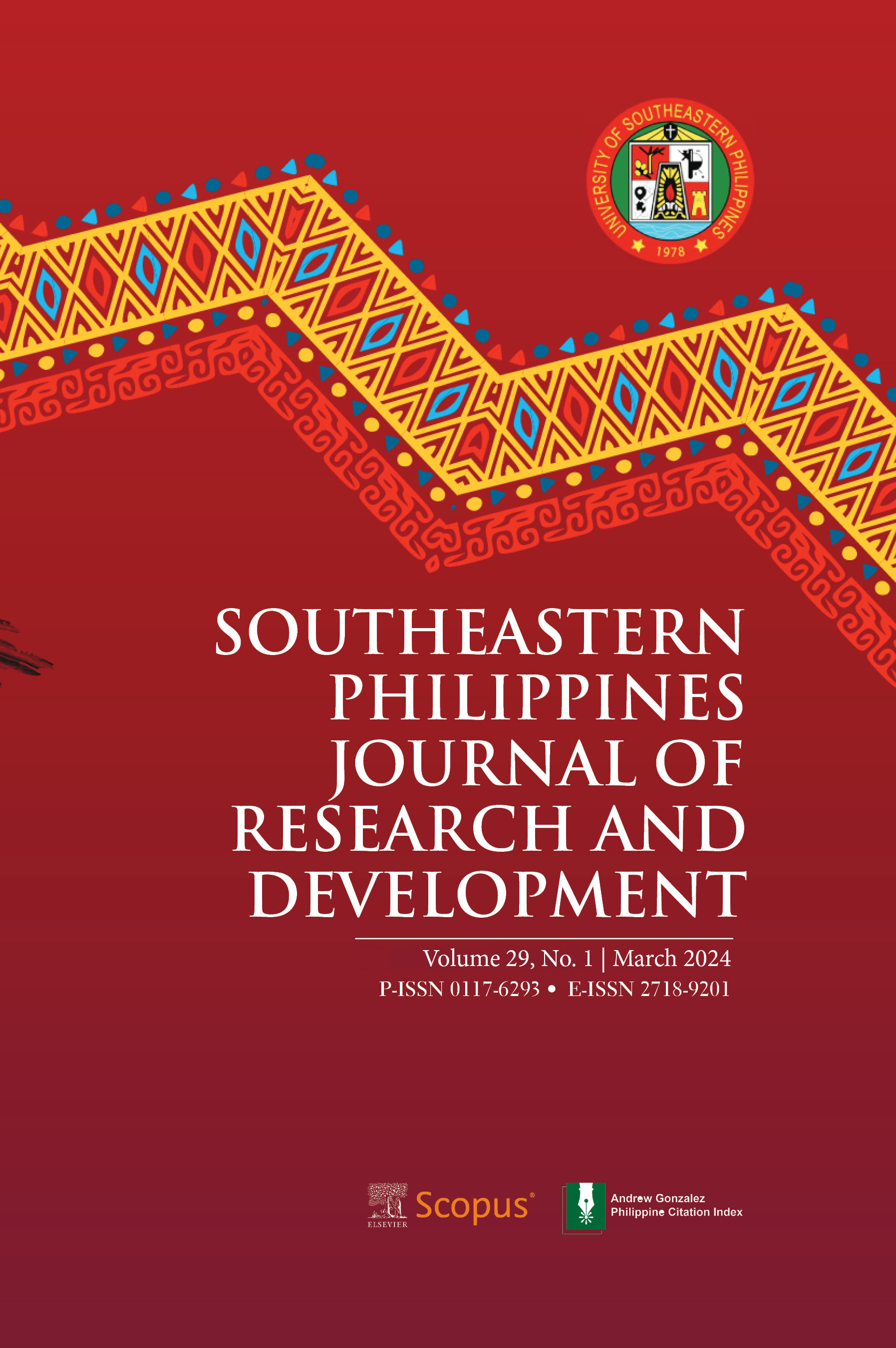
Editorial Preface
We welcome 2024 with an edition that brings together studies from scholars working individually or collaboratively. Out of more than 100 submissions, only six articles made it to this issue, drawing attention to the significance of keeping a keen eye on research projects that respond to the ASEAN region’s development needs.
In Phases of Filipino Proletarianism in the 20th Century Dagling Tagalog: A Critique Using Pierre Macherey’s Theory of Gaps and Silences, literary scholars, advocates, and activists will appreciate the meticulous analysis of seven Dagling Tagalog texts by Reah Izza T. Paglinawan of the University of Southeastern Philippines (USeP) and Hanafi Bin Hussin of the Universiti Malaya in Kuala Lumpur, Malaysia. By doing a thematic reading of Tagalog short prose, Paglinawan and Hussin uncover Filipino proletarianism and its phases during the 20th century that reflect the economic, political, and social struggles of Filipinos. The study informs the readers to be critical of the ideologies that govern the society and, more importantly, enlarges their consciousness of the history and culture of the Filipino nation.
Equally interesting in understanding the history and culture of the Filipinos is the study A Semantic Analysis of Cross-Linguistic Mondegreens: Implications on How Filipinos Interpret Meanings by Lourd Greggory D. Crisol of the Mindanao State University-Iligan Institute of Technology, Philippines. Employing qualitative content analysis, Crisol investigates how Filipinos make sense of misheard English lyrics. He concludes that “no matter what genre the songs belong to, they most likely would be shifted to the field of humor or comedy. Despite this tendency of humor shifting, this shows language indigenization and enrichment and reflects the positive Filipino spirit.”
Another important contribution to scholarship on linguistics is Scammer Strategies and Social Actions in Online Filipino Transactions by Kiarah Reyshylle C. Ibañez of the Department of Education-Region XI, Philippines. Using digital conversation analysis, Ibañez looks into the persuasive strategies and linguistic markers of online scammers and analyzes the social actions of both scammers and their targets. From a linguistic standpoint, the study addresses online financial scams and creates a safer space for virtual communications.
Two articles in this issue are from social science. In Food and Ayuda Narratives during the Pandemic in Remote and Small Island Communities in Northern Iloilo, Philippines, Raymundo R. Pavo of the University of the Philippines-Mindanao and Mary Barby P. Badayos-Jover and Farisal Ungkakay-Bagsit of the University of the Philippines-Visayas investigate the status and meaning of food insecurity in four municipalities in Northern Iloilo. After a series of focus group discussions, the researchers from UP underscore the importance of knowing people’s subjective notions of food security as this will help government institutions design programs to reduce food insecurity in times of crisis.
The other article on social science, Whispers of Wisdom: Exploring the Essence of Partandaan in Suluk Indigenous Mediation by Nurhasan Danial and Asmiaty Amat of the Universiti Malaysia Sabah and Nelson Dino of the Mindanao State University-Tawi-Tawi, focuses on the indigenous knowledge of the Suluk (Tausug) mediators in Sabah, Malaysia. It reveals that objects, social acts, and language carry symbols that influence the thinking and living of the Tausug as peace-loving people. The researchers suggest that policymakers should consider developing programs that integrate the Suluk indigenous mediation into the formal conflict resolution mechanism in the Tausug communities.
This edition closes with a contribution from the field of agriculture. In Assessment of All-in-One Fertilizers and Foliar Spray for Nutrient Management of GCTCV-218 Cavendish Banana Seedlings, Jonathan A. Bestes of International Veterinary and Agrochemical, Inc. and Dernie T. Olguera of USeP address concerns on productivity problems of Giant Cavendish Tissue Culture Variant 218. Based on experimental research, the study recommends that a fertilization program with positive return can be attained when Haracoat all-in-one fertilizer and foliar spray are applied in GCTCV-218 seedlings under nursery conditions. This is a significant finding related to banana production, as the Philippines is the number one exporter of Cavendish bananas in Asia.
The range of issues in this edition attests to a vast number of social, cultural, political, and agricultural problems in the ASEAN, informing scholars to continue pursuing and doing research for the development of the present and future generations. Hence, let me express my heartfelt gratitude to all the contributors and reviewers for shaping the discourse of this Scopus-indexed journal.
Sajed S. Ingilan
SPJRD Editor-in-Chief
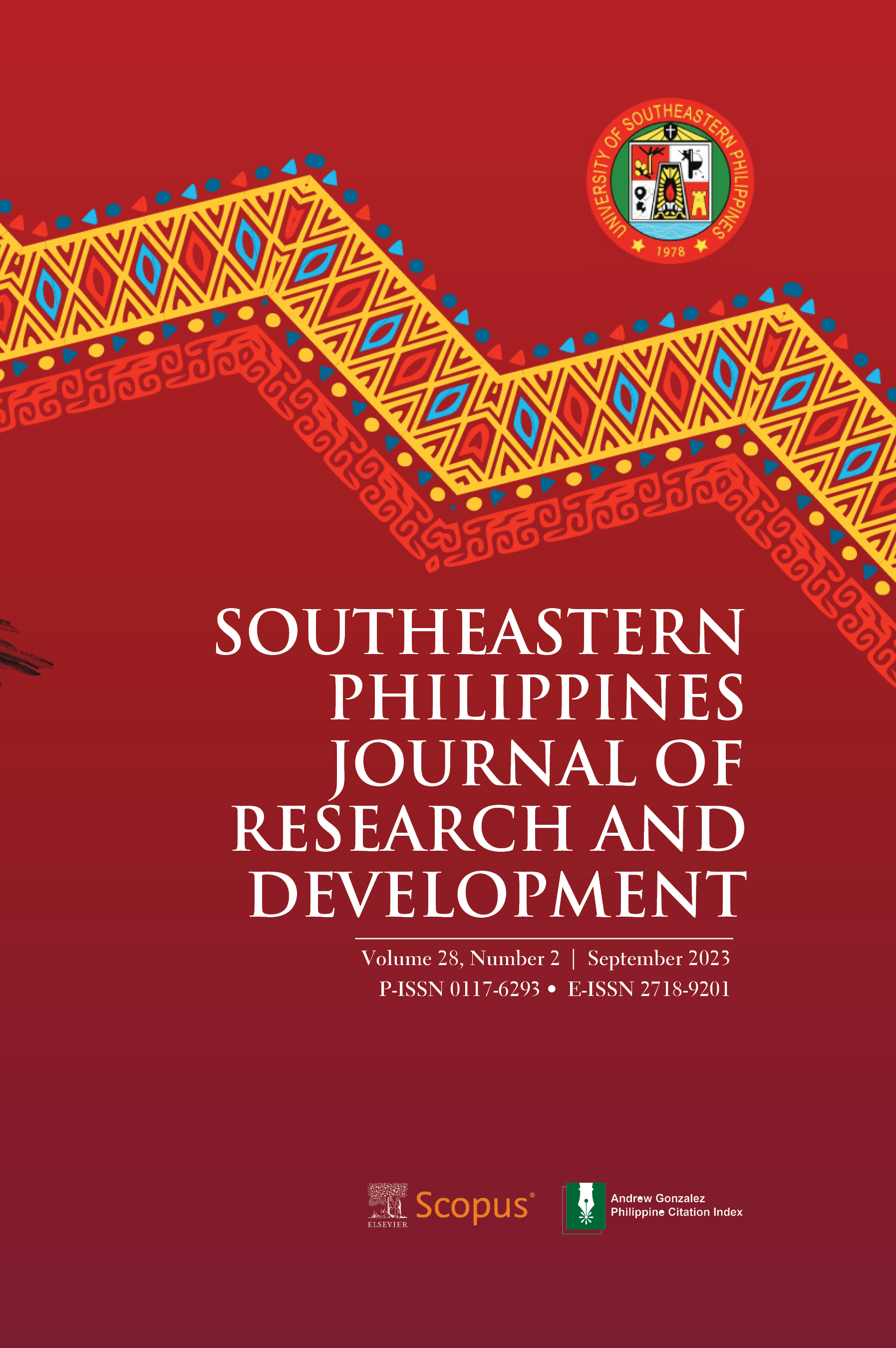
Editorial Preface
The Southeastern Philippines Journal of Research and Development releases Volume 28, Issue 2, with its monumental achievement of being indexed in the renowned Scopus database. This milestone serves as concrete evidence that the SPJRD Editorial Board and the contributions of its authors have effectively reached a global audience. Moreover, the inclusion of its articles from 2021 up to the present in the Scopus database enhances the reputation and credibility of the researchers and promotes research collaboration with international scholars.
The SPJRD continues its commitment with the publication of the September 2023 issue that discusses matters of race, culture, language, and business in the ASEAN, all familiar but still critical and relevant issues to our times. Out of 33 submissions, only five articles passed the stringent peer review process.
Nasirin Abdillah of the Universiti Teknologi MARA in Malaysia, in A Fictocritical Narration of the Complexity of Nation-Building in Malaysia, looks at the sociopolitical, cultural, and mythical nuances in the form of creative arts where the genre of fictocriticism serves as a creative contextualization narrating the complexity of the idea of nation and racial identity. Abdillah argues that “the dreams of a truly united Malaysia can be realized through the arts, not necessarily via history subject, and in this case, by creating the story of a nation.”
If the previous article contributes to the idea of narrating the nation – its hopes and aspirations, in the context of creative arts, Cultural Motifs in Blaan Flalok: Revitalization of Oral Lore for Preservation, Development, and Sustainability by John Vianney S. Trocio of the Department of Education (DepEd), Philippines, and his co-writers from DepEd, Conrado and Ladislawa Alcantara Foundation, and the University of Southeastern Philippines, provides more starting points for enduring cultural motifs to be part of the broader cultural appreciation reflected in Philippine arts. Following ethical and credible approaches to working with Blaan, an indigenous people group in General Santos, Saranggani, and South Cotabato, Philippines, the study of Trocio and his colleagues revealed that the frequent Blaan cultural motifs on the flalok included familial relationships, domestic work, tribal war, competitions, animal trapping, and agricultural farming. The study could be used as supplementary readings and positive entry to professionals working with indigenous cultural communities, or partnering for research.
Also concerned with indigenous peoples (IPs) in Mindanao, but this time through linguistics is the paper Politeness Strategies of Manobo Students in a Classroom in Kidapawan City, Philippines by Rea Rodesa Sandoval-Delos Santos of the Ateneo de Davao University and her counterparts from Davao Doctors College, USeP, and Muban Chombueng Rajabhat University-Thailand. Employing qualitative analysis, Sandoval and her co-authors found that the Manobo students have different politeness strategies depending on their relationship with the interlocutors in the classroom interaction. Scholars of linguistics and education will draw insights from the findings that there could be more ways of improving the learning atmosphere with IPs as students.
The last two articles of this issue deal with business. In Preliminary Analysis of Cross-shareholding in the Green Supply Chain and Recommendations for Regulatory Policy in the Philippines, Tran Nguyen Phuoc Thong and Dao Thi Thu Hang of Vietnam National University confirm that the cross-ownership can help businesses in the network share costs, including the cost of producing green products to protect the environment. Deploying the method of jurisprudence, Thong and Hang offer some recommendations that aim to refine policy and legislation in the Philippines to effectively utilize trade credit, equity ratios, and cross-shareholdings in supply chain management.
The other article on business, Predictors of Internet Banking Services Adoption among Depositors in Davao City, Philippines, by Rimark Inhambre of East West Rural Bank, Inc. in Davao City and Rosfe Corlae Badoy of USeP draws attention to the need for heightened awareness of internet banking services, its risks and benefits, in order to increase patronage and protection among the clients.
Rigorously vetted by international experts, we hope this edition will inspire scholars and critics to continuously engage with issues that beleaguer us in order to develop forward-looking projects, activities, and policies. Through this, we aim to contribute to the sustainable development and resilience of our communities in the ASEAN, thereby ensuring a more promising future for generations to come.
Sajed S. Ingilan
SPJRD Editor-in-Chief
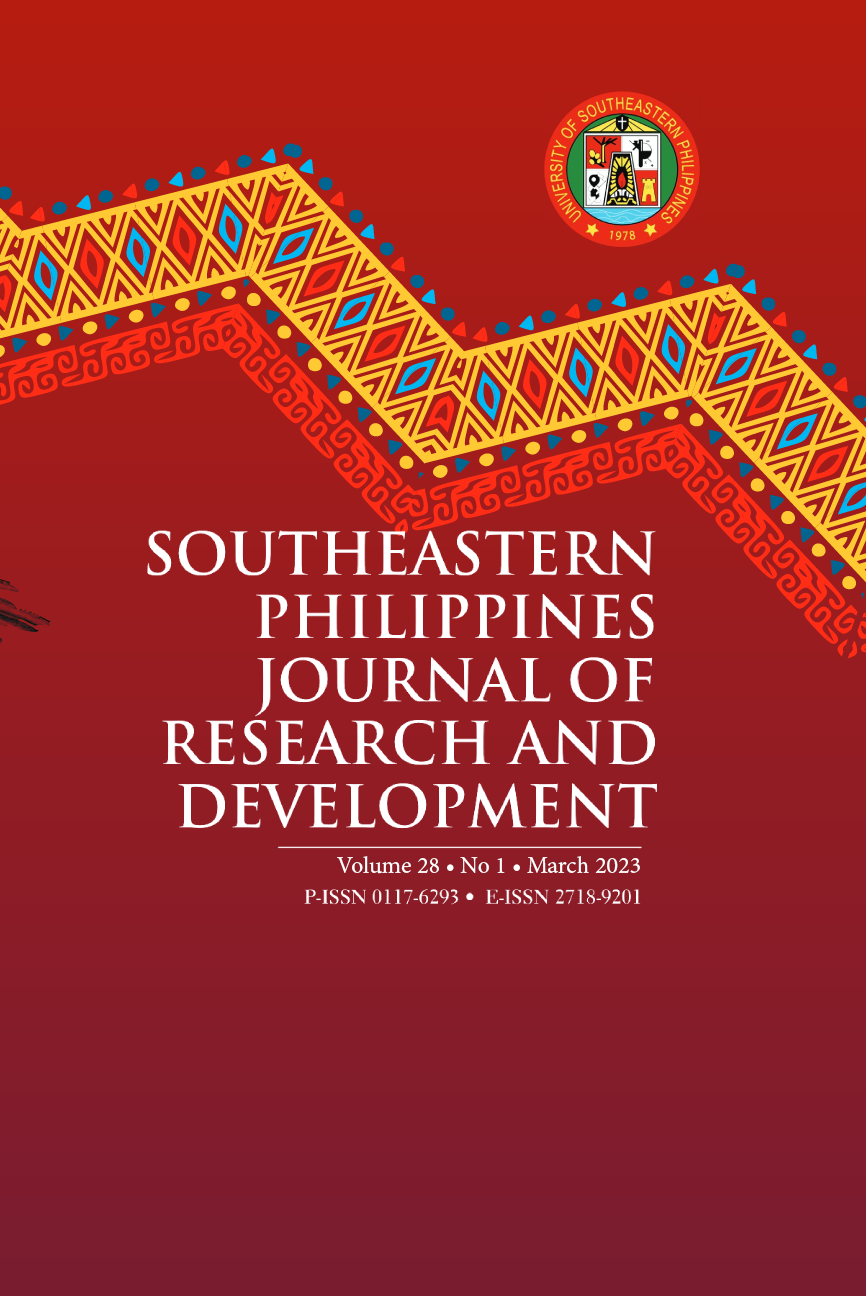
Editorial Preface
We are pleased to announce the release of Volume 28, Issue 1, of the Southeastern Philippines Journal of Research and Development (SPJRD), the official international, peer-reviewed, and open-access journal of the University of Southeastern Philippines.
SPJRD Volume 28, Issue 1, features five articles out of 41 papers submitted to the journal by researchers worldwide. This suggests that the SPJRD pays enormous attention to the quality of the papers it accepts for publication. Moreover, the recent inclusion of its issues in the Andrew Gonzales Philippine Citation Index attests to its commitment to publishing research articles on par with the international research community’s standards.
In the first article of this issue, Tran Nguyen Phuoc Thong from the Cooperation Center for Lawyer Training on International Trade, Judicial Academy in Ho Chi Minh City, Vietnam, evaluates the influence of cross-ownership in Philippine and Vietnamese laws through agency theory and corporate governance models and makes some recommendations for Philippine and Vietnamese laws.
In the second article, Daisy T. Besing and Rhinna M. Saan of the University of Southeastern Philippines zero in on the productivity and financial performance of income-generating projects (IGPs) of a Philippine state university in the Davao Region, Philippines. They end their paper with a proposal for strategic decisions to improve the performance of IGPs of a Philippine state university.
The next two articles talk about Philippine literature and culture. Takashi Tsuji of Saga University in Japan explores the Philippine society and culture by analyzing the structure and content of Philippine folktales featuring monkeys found among Ilokano, Kalinga, Tinguian, Tagalog, Bicolano, Ilonggo, Meranaw, Bukidnon, Kapampangan, and Bisaya. Tsuji concludes that, contrary to the cunning and selfishness of the monkeys in folktales, the monkey is symbolic of pursuing the virtues of a culture rooted in reciprocal relationships, which Filipinos value the most.
The other article on Philippine literature and culture highlights the unsung hero of Tapul Island, Sulu, Philippines. Nelson S. Dino, Mary Joyce Z. Guinto-Sali, Al-Haniff Lee Matolo of the Mindanao State University in Tawi-tawi and their counterparts from Universiti Malaysia Sabah and USeP, examine the character archetypes of Panglima Sayyadi based on kissa, an oral narrative passed down through generations.
The article of Dino and his colleagues does not only reveal the characteristics of Panglima Sayyadi as a leader of the Sulu Forces, but more importantly, serves as an inspiration to the young generations of Tau Sug to protect their hula (homeland), bangsa (nation) and agama (religion) against the colonizers.
Ending this issue with applied linguistics and religious studies, the article of Raymund T. Palayon of the Muban Chombueng Rajabhat University and David D. Perrodin of the Mahidol University in Thailand investigates the characteristics of Christ claimants by focusing on the language in their discourses from the aboutness and communication style perspectives. The use of corpus-based methodology by Palayon and Perrodin offers a new perspective on identifying the characteristics of Christ claimants, which is underexplored in applied linguistics and religious studies.
The articles in this volume deal with issues and perspectives of crucial importance to our country and the ASEAN. Hence, let me end this note with sincere felicitations to our authors, editors, reviewers, and the USeP Publication Board for realizing this scholarly endeavor.
Sajed S. Ingilan
SPJRD Editor-in-Chief

Editorial Preface
The articles in the SPJRD Volume 27 Number 2 deal with topics in aquaculture, literary and cultural studies, and linguistics. These articles address issues of development of crucial importance to our country, in particular, and the ASEAN , in general.
In the first article of this issue, Rosannie Joy T. Paglinawan, Ruby A. Paylangco, Jesil Cris C. Paylangco, Archie A. Along, and Florence Jhun F. Almadin of Caraga State University contribute to the environmental monitoring and conservation of Lake Mainit, one of the most valuable freshwater resources in the Caraga Region by conducting a study to determine the association of endo-parasite present in the gut, diet composition, and length and weight of C.striate Bloch, locally known as haluan.
The next three articles in this issue feature literary and cultural studies. The second article focuses on Aswang, White Lady, and Diwata in Philippine creature urban legends. Employing the structuralist framework by Leach (1973) and folktale category by Propp (1958), Joseph P. Casibual, Jr. of Western Mindanao State University explores the relevance of folklore in the digital age as a way of understanding our cultural and literary identity.
The third article by Takashi Tsuji of Saga University in Japan examines the mouse deer, called pilanduk, as a trickster based on the folktales from four indigenous cultural communities in the Philippines: Tausug, Samal, Maranao, and Manobo. Tsuji concludes that developing a deeper understanding of the mouse deer will help further the investigation of the relationship between them and the Filipinos.
The fourth article by Angelo Lenard E. Yu of USeP, Ezzedin M. Manidoc of Kolehiyo ng Pantukan in Davao de Oro, and Takashi Tsuji of Saga University investigate the social, economic, political, and religious practices present in the Kagan folktales from Davao Oriental and Davao de Oro, Philippines. The study of Yu, Manidoc, and Tsuji enlarges our cognizance on the cultural history of the Kagan and their ethno-relationships with the indigenous cultural communities in Mindanao and Sulu.
The final section of this issue highlights the Cebuano language. Joseph Araneta of Davao Doctors College and Sajed S. Ingilan of USeP analyze the pragmatic functions of agreeing and disagreeing formulaic expressions in the Cebuano language, namely o/oo, lagi, mao, bitaw, wala, and dili. The study of Araneta and Ingilan widens our knowledge in understanding the idiosyncrasies of the Cebuano language.
Reviewed by Filipino and non-Filipino scholars, the articles in this issue will not only facilitate our consciousness on the resources and culture in the Philippines, but more importantly, will lead to creation of research and development projects in the Philippines and beyond.
Sajed S. Ingilan
Editor-in-Chief
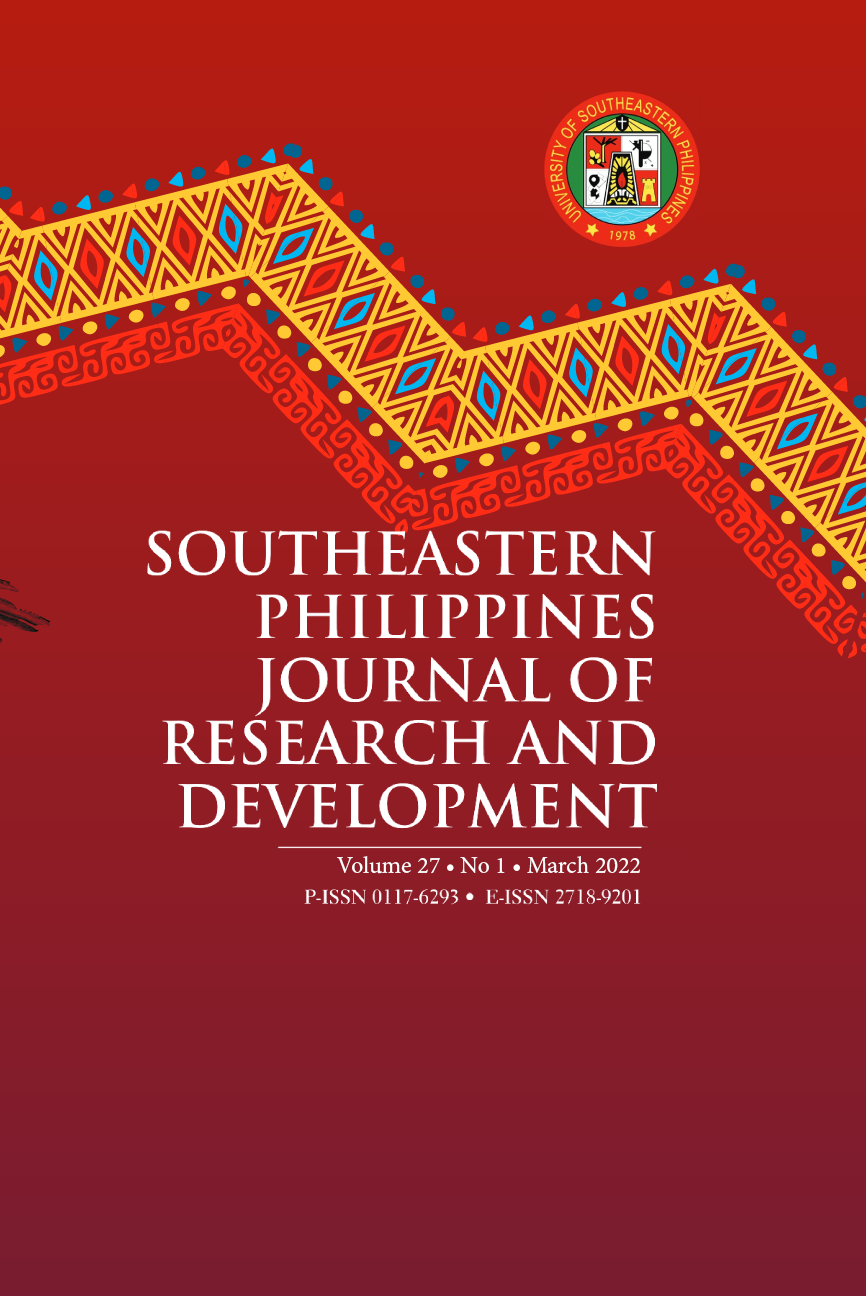
Editorial Preface
The latest issue of SPJRD features articles that reflect the conditions and developments in the Philippines. The themes included in this issue offer illuminating insights into the cultural and socio-economic developments of the Philippines and the ASEAN in general.
In the first article of this issue, Mohamed Taha and Fazal Mohammed Mohammed Sultan of the Universiti Kebangsaan Malaysia (National University of Malaysia) explicate the properties of unaccusatives in a particular variety of Arabic language using the Minimalist Program. The findings of the study of Taha and Mohammed provide rich information to comparative syntax, linguistic theories, and language typology, and have a significant contribution to a better understanding of the structure of the language of Islam, the religion of the Bangsamoro, and the most widely practiced religion in Southeast Asia.
The second article in this edition moves on to talk about the tourism industry in North Cotabato, Philippines. Fredelino A. Galleto, Jr. of the University of Southern Mindanao and Frediezel G. de Leon of the University of the Philippines Visayas evaluate the community's attitude and support level of tourism in Asisk-Asik Waterfalls in North Cotabato. Galleto and de Leon note that drawing insights from the locals' viewpoints toward tourism in Asik-Asik Waterfalls and the variables that potentially contour their perceptions is imperative for government, policy-makers, tourism planners, not only to win the local populace's approval but also to guarantee success of tourism undertakings.
Focusing still on North Cotabato, the third article written by Marnie Grace I. Sonico of the University of Southeastern Philippines investigates the insect diversity in an organic rice farm in Barangay Langkong, M'lang. The findings of the study of Sonico can be used to maintain an efficient, productive, and sustainable agroecosystem.
This issue also includes a study on the sustainability of a socio-economic organization in Ilocos Sur, Philippines. Archie Martinez of the University of Northern Philippines gives insights into the strengths and weaknesses of the agrarian reform beneficiaries (ARB) organization that can guide the core team of the organization and the Department of Agrarian Reform to survive against all economic challenges.
The final section of this edition draws attention to the impact of the COVID-19 pandemic on the mental health of employees. Jennifer M. Arbiol, Edeliza S. Gonzales, and Angelie V. Cabajes of USeP explore the level of psychological well-being of employees of a Philippine state university during the COVID-19 pandemic. The results of the study of Arbiol, Gonzales, and Cabajes can help the university administration to strategize in providing assistance to the employees in times of health crisis.
Reviewed by scholars from the United States of America, Malaysia, Japan, Yemen, and the Philippines, the articles in this issue contribute to the ongoing discourse on cultural and socio-economic developments in the region.
Sajed S. Ingilan
SPJRD Editor-in-Chief
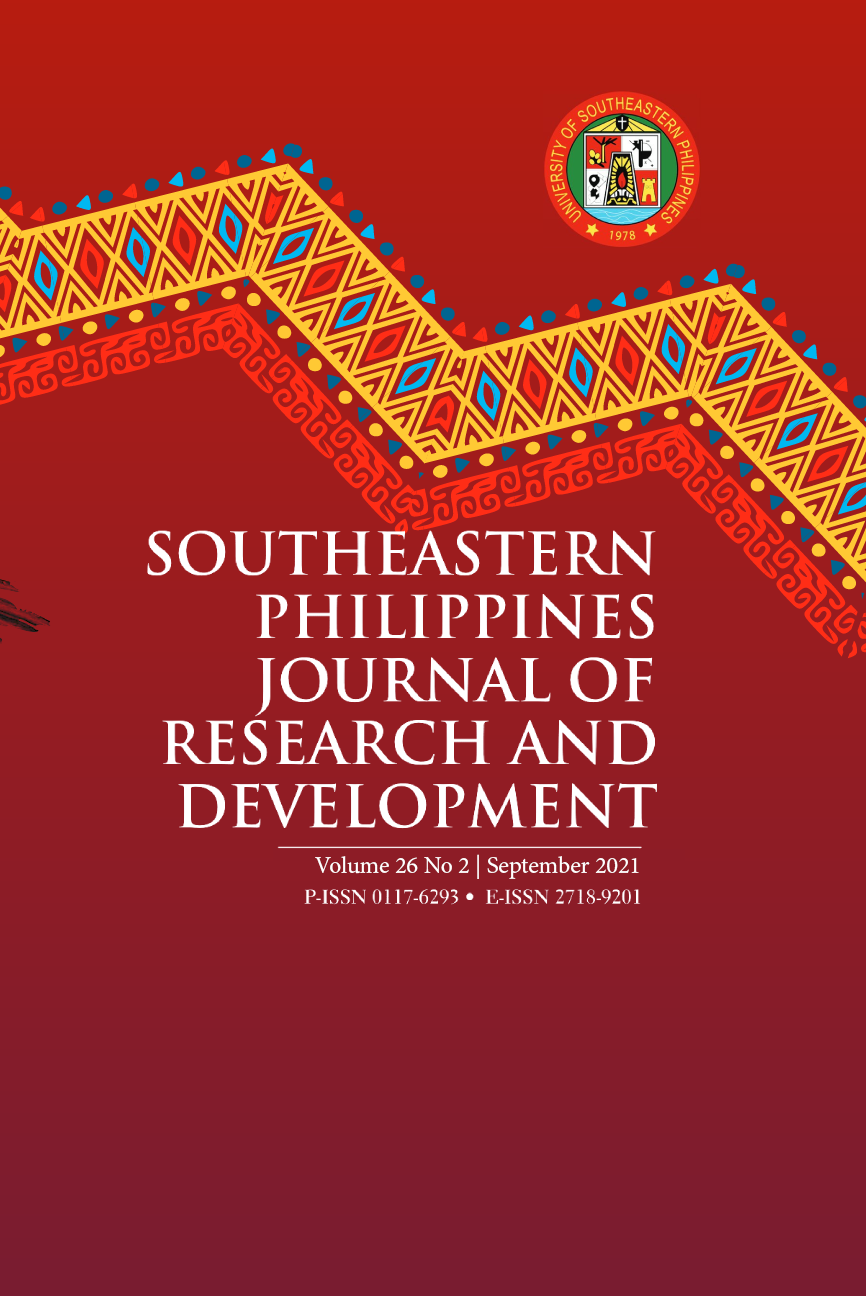
Editorial Preface
The contributions to the latest issue of SPJRD cover a diverse range of topics. They range from issues in agriculture such as milk uses, abaca production, and bamboo utilization, and in language and literature of cultural communities in Mindanao, Philippines. All these articles address issues of development of crucial relevance to our country.
In the first article in this issue, Takashi Tsuji of the Saga University in Japan emphasizes that the use of water buffalo milk is a special culture in the Philippines and even in Southeast Asia. Tsuji analyzes the dairy transition currently occurring in our country and concludes that dairy culture has become a major industrial farming system in the Philippines.
Mechelle R. Mangmang and Katherine L. Cozo of the University of Southeastern Philippines offer a strategy to increase the production of abaca, a significant contribution to maintain our status as a leading producer of abaca in the world market.
Isao Hirota of the Gifu University and Takashi Tsuji of the Saga University, both based in Japan, explore the contribution of bamboo to various aspects of livelihood of the Pala’wan on Palawan, Philippines. Hirota and Tsuji strongly recommend the use of ethno-bamboo approach to uncover the new aspects of the relationship between bamboo and people.
To give voice to what has been silenced in the discourse of the majority, this issue also highlights language and literary studies about the cultural communities in Mindanao. Dr. Rodney C. Jubilado of the University of Hawaii at Hilo in the United States of America scrutinizes the morphosyntax of Isamal, an Austronesian language spoken by the indigenous people of Island Garden City of Samal. Using the Minimalist Program, the article of Jubilado is the first attempt to analyze the morphosyntax of ergatives of Isamal language.
Focusing still on the Island Garden City of Samal, Josephine May Grace A. Famoso of the Mindanao State University-Iligan Institute of Technology examines the structure of the Sama folk narratives such as legends and folktales. Famoso then elucidates the cultural practices seen in the folk narratives.
Nena C. Abdurajak of the Western Mindanao State University and Sajed S. Ingilan of USeP unveil the culture of the Tausug of Sulu in doing jihad or holy war by translating the Tausug parang sabil or folk narrative song into English. The article of Abdurajak and Ingilan contributes to the development of positive discourse on Tausug culture.
Jenifer R. Tuban of USeP studies the culture of the Bagobo Tagabawa, an indigenous people group in Davao Region, by analyzing their folk speech such as proverbs and riddles. Tuban points out that the Bagobo Tagabawa folk speech is more akin to the folk speeches of the different cultural communities in the Philippines.
Critiqued by international scholars, this collection of articles thus addresses a broad range of issues that seek to enlarge our consciousness in agriculture, language, and literature, and more importantly, contributes to the ongoing conversations on the economic and cultural developments of the Philippines.
Sajed S. Ingilan
Editor-in-Chief
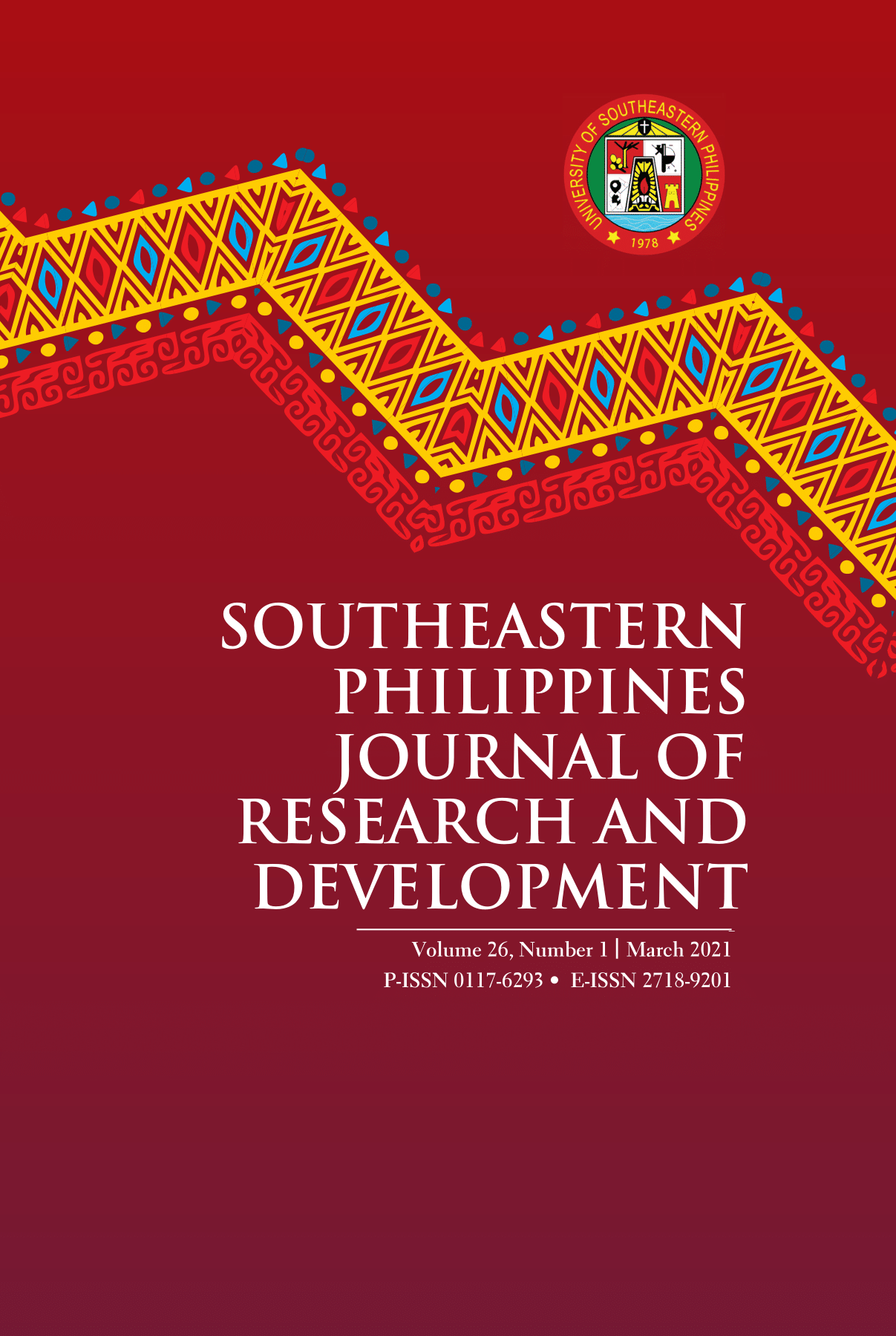
Editorial Preface
The Southeastern Philippines Journal of Research and Development has, over the years, provided an important niche for the works of scholars on aspects of Mindanao region’s socio-economic development. The current edition continues and develops this significant role of the journal in responding to the needs of Mindanao, Philippines. The articles in this edition deal with issues from humanities, and biology.
In the first article in this edition, Dr. Rodney C. Jubilado, Chair of the Humanities Division of the University of Hawaii at Hilo, United States of America, provides a comparative analysis of the ergative and accusative structures of Philippine languages, namely, Isamal, Cebuano, and Filipino. The varieties of these languages are the ones used in the Island Garden City of Samal, Philippines. The findings of the study of Dr. Jubilado have a significant contribution to the preservation of Philippine indigenous languages.
Staying with the scholarship on socio-cultural studies, Dr. Takashi Tsuji of Saga University, Japan, contributes to the discourse on Philippine literature and research as he investigates Philippine folklore of saltwater crocodiles. Based on the eight types of crocodile folklore, Dr. Tsuji specifically examines how Filipinos, particularly from Palawan and Mindanao, have recognized crocodiles in the past and coexisted with them for hundreds of years.
This issue also highlights the articles from the field of biology: Dr. Samuel Herbert T. Mamora of the University of Southeastern Philippines analyzes the floristic composition and diversity of weeds in organic rice fields in Langkong, Mlang, North Cotabato, Philippines that could lead to a better understanding of the rice agroecosystem and improvement in weed management; Glenn Vallespin of the University of the Philippines Mindanao and his counterparts from Caraga State University, Butuan City, Philippines examine an in-depth relational analysis of human-induced stress and habitat contraction with bat species in the neighboring roosting sites in Caraga State University in Butuan City; and Lawrence P. Deligero of Davao Medical School Foundation and Hilario L. Wong, Jr. of the University of Southeastern Philippines explore the alternative morphometric characters that could be used to estimate the larval age of red palm weevil (RPW), Rhynchophorus ferrugineus.
Reviewed by international scholars, the collection of articles in this issue will not only facilitate and enlarge our consciousness of the region’s uniquely rich culture, but more importantly, will contribute to the creation of projects geared towards the socio-economic development of Mindanao.
Sajed S. Ingilan
Editor-in-Chief

Editorial Preface
The content of this Special Issue of the Southeastern Philippines Journal of Research and Development focuses on food and agriculture: technologies to improve production, detection and management of plant and animal diseases, remedying ill conditions of both crops and animals, locating the most suitable areas to plant crops, and most importantly finding smart, innovative and sustainable means to enhance the country's agricultural sector. In a nutshell, the authors of the studies in this issue forward ways on how we could further live and survive, as the need for food is heightened by a health crisis that, as everyone by far already knows, has struck the world's systems.
Conducted before the COVID-19 pandemic became a byword to most Filipinos, these studies “ brought in large part by agricultural scientists, engineers and student researchers from USeP “ are products of a scientific conference themed Sustainable Agroecosystems and Emerging Innovations (SAEI). Presented in this issue are eleven discussions and contributions on grassroots-based innovations, clean energy, food preservation, crop health, among other agricultural technologies and discoveries. In a way, these researches are part of the pursuit to address a nation's health and survival.
A question on the adequacy of food cannot be pinned down to a mere Yes or No without further explanation. As conference organizers and Journal editors, we hope that these studies would make the best sense as answers to a curiosity raised in the time of pandemic: do we have enough food?
We hope then that the individual articles prod readers to recognize the importance of agriculture and how it responds to the needs of the future. Though the pandemic creates significant blows to the economy, our resources, and people's lives, the promise of agricultural science continues, engendering ideas and delivering technologies to communities. The future is assured that scientific curiosity and advancements in food science and engineering will find ways to take care of humanity's needs. Truly, there is no better time than now to read and be reminded of the possibilities of hope that these researches bring.
Here is the rundown of articles in this Special Issue, covering agroecosystems and innovations:
An integration of solar-powered pumps in the irrigation system in rice-fish farming, by Ryan M. Abenoja; Development of a provincial land suitability map of solar-powered irrigation system for local farmers and LGUs, by Sheila C. Cogay, Ireneo P. Amplayo, Roland R. Bayron and Ruben V. Cantones; Effect of absorbent polymer in improving moisture retention in the soil and on the growth response of banana, by Ruel F. Tuyogon;
A study on the physicochemical characteristics of soils under cacao production, by Nelvin A. Villason and Dernie T. Olguera; Preharvest application of the compound 1-MCP on postharvest quality of banana, by Bryl I. Manigo and John Paul Matuguinas;
An investigation of the potential of vermicompost drippings as foliar fertilizer for lettuce by Ulysses P. Besas, Sinneth Caniones and Larry V. Aceres; Testing of a locally made vermitea vortex brewer, by Kzyl Mae S. Albiso;
An examination of the storage quality of fresh yacon, by Joyce C. Limbaga and Katherine C. Israel; and, articles dealing with diseases, such as Identification of the severity of anthracnose in Carabao mangoes using the DigiMango mobile app, by Louie G. Simbajon, Gia C. Mata, Dessa L. Ybanez and Dhally A. Ilisan; plus a Survey on the extent of usage of traditional medicine in controlling parasites in native chicken, by Hyde D. Nadela. We would like to give a special mention to Belly T. Dionio, Carlo Jun M. Bacoba, Cecirly G. Puig and Fernan A. Ramos's First Report on Fusarium heart rot on pineapple in South Cotabato and Davao City.
We are grateful to the specialists and experts who shared their insights during the SAEI International Research Conference and played critical roles in the vetting process.
May this collection of articles not only facilitate and add to the academic community's knowledge on agricultural science and engineering but also contribute to the creation of development projects to impact marginalized communities in Mindanao and the country as a whole. Readers interested in contributing articles along the theme of sustainable agroecosystems and emerging innovations, as well as the other themes reflecting the University's research agenda (see Information for Authors, last page), are highly encouraged to submit their manuscripts for review (for a 2021 Journal release date).
With our readers support and future contributions reaching our editors desks, the SPJRD shall strive to carry on creating a niche for scientific research from the peripheries.
Anne Marie Jennifer E. Eligio, Editorial Adviser
Sajed S. Ingilan, Editor-in-Chief
SPJRD
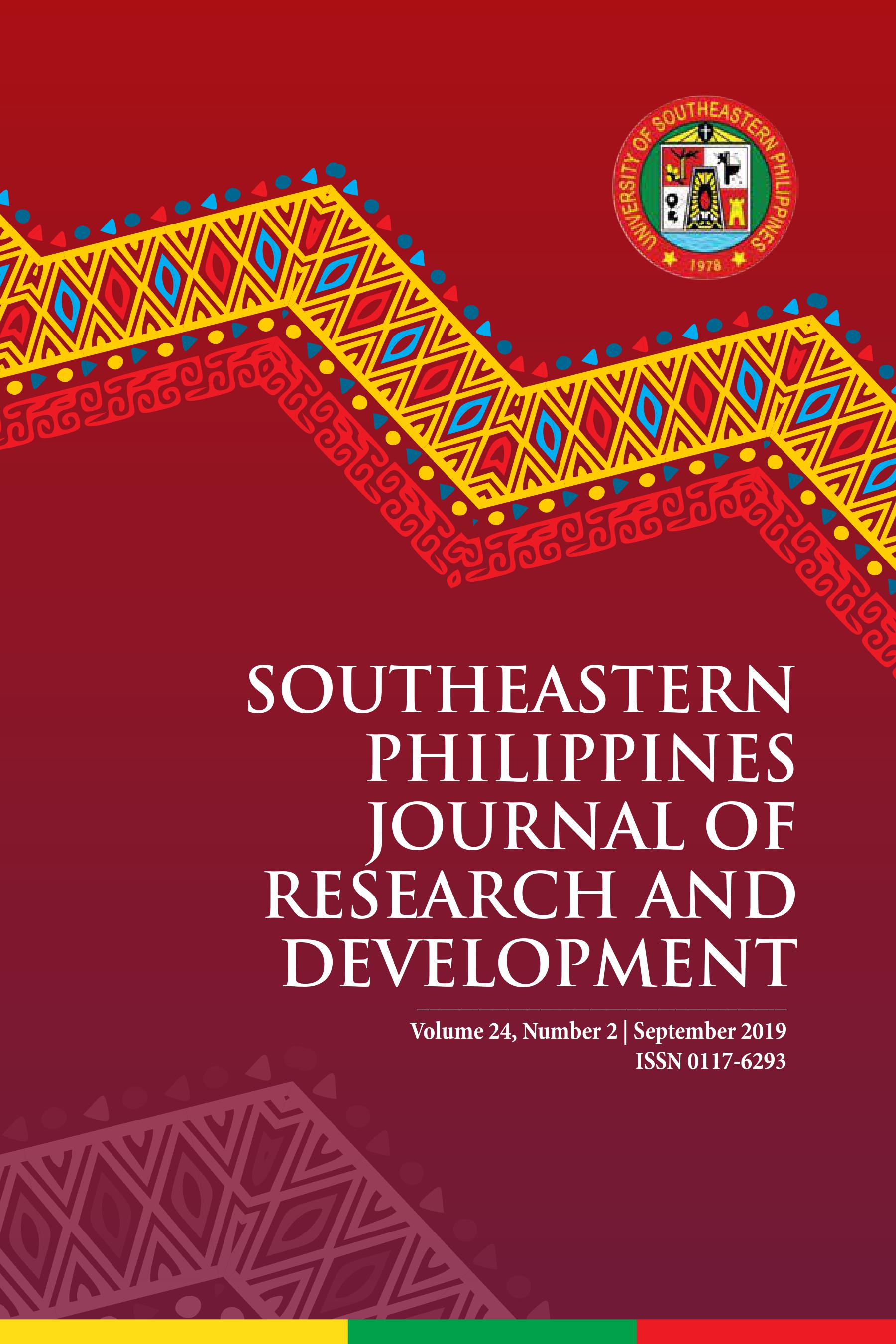
Editorial Preface
Producing and releasing Volume 24 Number 2 of the SPJRD or the Southeastern Philippines Journal of Research and Development is no walk in the park, especially when the Journal strives to rise to the challenge of publishing papers that we hope would create ripple effects on academic-and-non-academic circles alike.
Despite challenges, the Journal continuously aims to provide readers with high quality peer-reviewed scholarly articles on a wide variety of issues which are the outputs of the hardworking researchers of the University Southeastern Philippines.
In order to position SPJRD as one of the most authoritative journals on research and development, I am delighted that we’ve tapped such a respectable group of International and Local Review Board members – scholars from the Visayas State University, Cebu National University, University of Southern Mindanao, Ateneo de Davao University, University of the Philippines Los Banos, University of the Philippines Mindanao, Charles Darwin University, and the International Rice Research Institute. During the 3-month period of peer review, producing 14 peer review reports from this fine set of reviewers-academicians, our authors painstakingly addressed editorial concerns and showed us much grit in handling tough peer reviewer’s comments. Some of the authors have had their baptism of fire and making it to this list is worthy of much praise.
With our editorial board’s cumulative experience in various fields of education, this Journal brings representations of research outputs from different disciplines. Without the service, dedication, and valuable time the Board has exacted to produce this issue, SPJRD would not have been here. We give special mention as well to Dr. Genna J. Carmelo, through her office the Public and International Affairs, for the help particularly provided during the initial phase of seeking for external peer reviewers. Included in our thank you’s is the interim editorial board for jumpstarting the revival of the USeP Journal; your contribution has been and will always be invaluable.
As we in the Board move forward, it is our vision to have SPJRD publish an assemblage of manuscripts documenting rigorous R&D outputs from our very own USeP faculty, and more manuscripts from distinguished scholars from the other institutions. I would like to remind the readers that the success of our Journal depends directly on the number of quality articles submitted for review. Accordingly, I would like to request your participation by submitting manuscripts and encouraging your colleagues to submit as well. SPJRD provides authors with high quality, helpful reviews that are shaped to assist authors in improving their manuscripts. I very much appreciate your support as we strive to make SPJRD an influential Journal that could impact research and development efforts in Mindanao region and beyond
Cecirly G. Puig
Associate Editor
For all submissions, please follow the general format below: